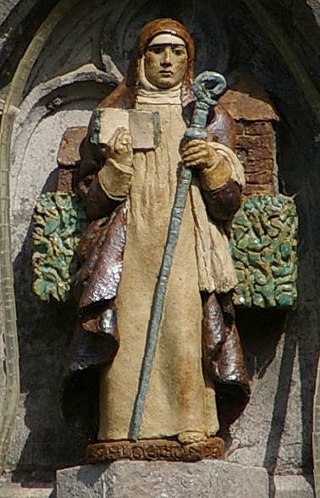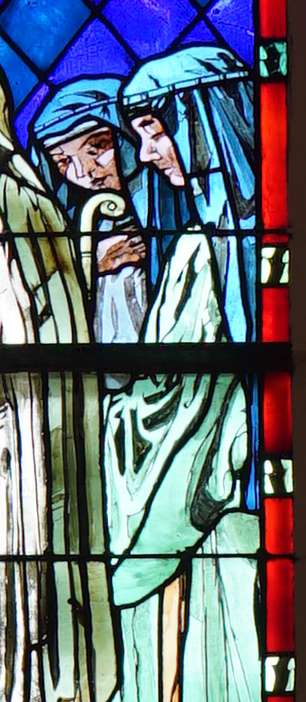
Aldegund, also Aldegundis or Aldegonde, was a Frankish Benedictine abbess who is honored as a saint by the Roman Catholic Church in France and by the Orthodox Church.

Ghislain was a confessor and anchorite in Belgium. He died at the town named after him, Saint-Ghislain.

Saint Waltrude is the patron saint of Mons, Belgium, where she is known in French as Sainte Waudru, and of Herentals, Belgium, where she is known in Dutch as Sint-Waldetrudis or -Waltrudis. Both cities boast a large medieval church that bears her name.

Saint Beuve and her brother Balderic lived in the 7th century in France. According to Christian Settipani, their father was probably Sigobert the Lame, King of Cologne, rather than Sigebert I of Austrasia, as indicated by Flodoard. Together they founded the Abbey of Saint Pierre de Reims. Beuve was the first abbess.

Maubeuge Abbey was a women's monastery in Maubeuge, in the County of Hainaut, now northern France, close to the modern border with Belgium. It is best known today as the abbey founded by St. Aldegonde, still a popular figure of devotion in the region. It is thought to have possibly been where the young Jan Gossaert, a Renaissance-era painter known as Jan Mabuse, was educated, claimed by some to have been a native of the town of Maubeuge, which grew up around the abbey.

Aldetrude was a Christian saint and from 684 was abbess of Maubeuge Abbey in the County of Hainault, now in northern France. She is also known as Aldetrude de Maubeuge, Aldetrude of Maubod, Aldetrudis and Adeltrude.

Saint Madelberte of Maubeuge was a 7th-century nun related to the Merovingian dynasty. She became abbess of Maubeuge Abbey in the County of Hainaut, now in northern France near the Belgian border. She died in 705 or 706.
Brunulphe III or Brunulphe III of the Ardennes , was a Frankish nobleman and Merovingian Count of the Ardennes. He was assassinated by King Dagobert I in the Middle Ages.
Alberic of the Ardennes, Alberick, or Albéric l'Orphelin de Hainaut d'Ardenne, also called the Orphan, was a Frankish nobleman and Merovingian Count of Hainaut.
Brunulphe or Brunulphe of the Ardennes was a Frankish nobleman and Merovingian Count of the Ardennes.
Saint Walbert IV(French: Sainte Walbert IV), also known as Vaubert, Waubert, or Waudbert was a Merovingian Count of Hainaut and a Frankish saint. He was the father of Saint Waltrude, and Saint Aldegund, first abbess of Maubeuge.
Walbert I, Vaubert, Waudbert, or Vautier also known as Walbert of the Ardennes was a Frankish nobleman and a Merovingian Count of Hainaut.
Walbert II also called the Younger, was a patrician, Roman senator, and Merovingian Count of Haynau and of the Ardennes.
Hydulphe, Hydulphus, Hidulphe, Hidulf, commonly known as Hydulphe of Lobbes(French: Hydulphe de Lobbes) was a Frankish saint who helped Saint Landelin establish Lobbes Abbey, Crespin Abbey, and Aulne Abbey.
Walbert III was a Frankish nobleman and a Merovingian Count.

Landry, Landric, Landericus, or Landry of Soignies, commonly known as Saint Landry of Metz was a Roman Catholic Bishop of Metz, Benedictine abbot of Haumont and Soignies, and a Frankish saint. He was the son of Saint Waltrude and Madelgaire.

Dentelin, Dentelinus, or Saint Dentelin of Soignies was a Frankish saint. He was the son of Saint Waltrude and Madelgaire.

Aubert of Cambrai or Aubertus was a Merovingian Bishop of Cambrai and Arras and a Frankish saint.

Saint-Martin Church of Cousolre or St Martin's Church of Cousolre is a church located in Cousolre, in the department of Nord, in the Hauts-de-France region of France.

Hautmont Abbey or the Abbey of Hautmont, was a Benedictine monastery in Hautmont in the department of Nord, France.









